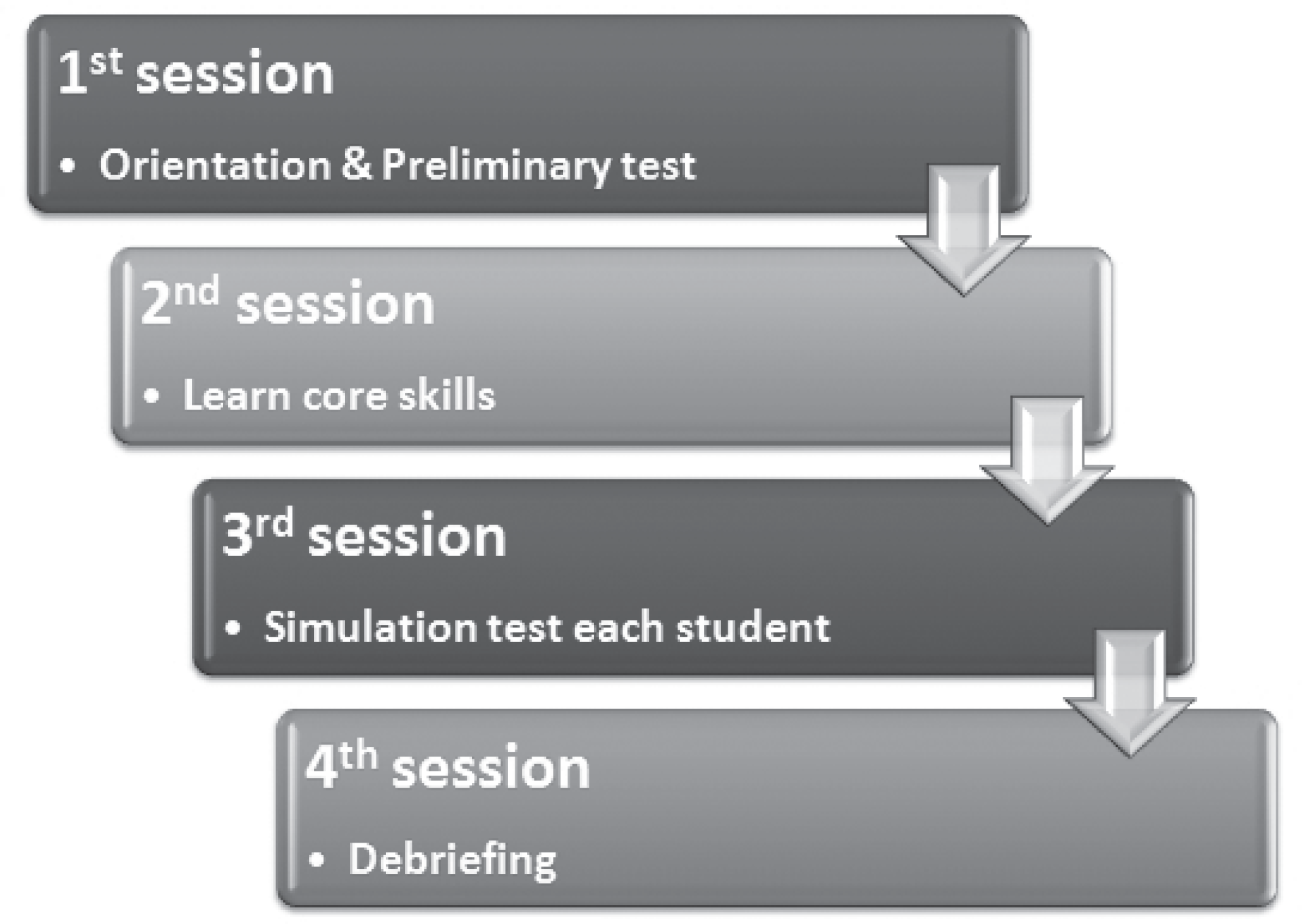Abstract
Purpose
Clinical training for nursing students is limited to rudimentary skills to avoid potential risks. Simulation-Based Training (SBT) can overcome the shortcomings of clinical training. We evaluated the educational effect of SBT for obstetrical nursing students using high-fidelity simulation courses.
Methods
We developed a simulation program for obstetrical nursing students to practice nursing skills that are necessary to provide quality care. The program consisted of four sessions. 1st: An orientation and a preliminary test. 2nd: Learning core skills required in obstetrical nursing. 3rd: Testing each student with scenario. 4th: Providing a debriefing session. At the beginning of the program, students were surveyed about their self-confidence in obstetrical nursing care, and at the end of the program, they were surveyed about the adequacy of SBT as well as self-confidence.
Go to : 
References
Alinier G., Hunt W &., Gordon R. 2004. Determining the value of simulation in nurse education: Study design and initial results. Nurse Education in Practice. 4:200–207. doi:10.1016/S1471(03)00066-0.

Baillie L &., Curzio J. 2009. Students’ and facilitators’ perceptions of simulation in practice learning. Nurse Education in Practice. 9:297–306. doi: 10.1016/j.nepr.2008.08.007.

Beaubien J M &., Baker D P. 2004. The use of simulation for training teamwork skills in health care: How low can you go? Quality & Safety in Health Care. 13:i51–i56.

Choi J Y., Jang K S., Choi S H &., Hong M S. 2008. Validity and reliability of a clinical performance examination using standardized patients. Journal of Korean Academy of Nursing. 38:83–91. doi:10.4040/jkan.2008.38.1.83.

Cohen J. 1988. Statistical power analysis for the behavioral sciences. 2nd ed.Hillsdale, NJ: Erlbaum.

Deering S., Brown J., Hodor J &., Satin A J. 2006. Simulation training and resident performance of singleton vaginal breech delivery. Obstetrics & Gynecology. 107:86–89.

Ellis D., Crafts J F., Hunt L P., Read M., Fox R &., James M. 2008. Hospital, simulation center, and teamwork training for eclampsia management: A randomized controlled trial. American Journal of Obstetrics and Gynecology. 111:723–731.
Eom M R., Kim H S., Kim E K &., Seong K. 2010. Effects of teaching method using standardized patients on nursing competence in subcutaneous injection, self-directed learning readiness, and problem solving ability. Journal of Korean Academy of Nursing. 40:151–160. doi:10.4040/ jkan.2010.40.2.151.

Fanning R M &., Gaba D M. 2007. The role of debriefing in simulation-based training. Society for Simulation in Healthcare. 2:115–125.
Feltz D L. 1988. Self-confidence and sports performance. Exercise and Sport Sciences Reviews. 16:151–166. doi:10.1249/00003677-198800160-00016.

Gardner R &., Raemer D B. 2008. Simulation in obstetrics and gynecology. Obstetrics and Gynecology Clinics of North America. 35:97–127. doi: 10.1016/j.ogc.2007.12.008.

Goffman D., Heo H., Chazotte C., Merkatz I &., Bernstein P S. 2008. Using simulation training to improve shoulder dystocia documentation. Obstetrics & Gynecology. 112:1284–1287.

Hertel J P &., Millis B J. 2002. Using simulations to promote learning in higher education: An introduction. Sterling VA: Stylus.
Jude D C., Gilbert C G &., Magrane D. 2006. Simulation training in the obstetrics and gynecology clerkship. American Journal of Obstetrics and Gynecology. 195:1489–1492. doi:10.1016/j.ajog.2006.05.003.

Lasater K. 2007. High-fidelity simulation and the development of clinical judgement: Students’ experiences. Journal of Nursing Education. 46.
Maslovitz S., Barkai G., Lessing J., Ziv A &., Many A. 2007. Recurrent obstetric management mistakes identified by simulation. Obstetrics & Gynecology. 109:1295–1300.

McCaughey C S &., Traynor M K. 2010. The role of simulation in nurse education. Nurse Education Today. 30:827–832. doi:10.1016/j.nedt.2010.03.005.

McIntosh J B., Alexander M., Veitch L &., May N. 1997. Evaluation of Nursing Times. 93:46–48.
Mikkelsen J., Reime M H &., Harris A K. 2008. Nursing students’ learning of managing cross-infection scenario-based simulation training versus study groups. Nurse Education Today. 28:664–671. doi:10.1016/ j.nedt.2007.11.003.
Mole L J &., McLafferty I H. 2004. Evaluating a simulated ward exercise for third year student nurses. Nurse Education in Practice. 4:91–99. doi: 10.1016/S1471(03)00031-3.

Moule P., Wilford A., Sales R &., Locker L. 2008. Student experiences and mentor views of the use of simulation for learning. Nurse Education Today. 28:790–797. doi:10.1016/j.nedt.2008.03.007.

Park H., Lee J., Hwang H., Lee J., Choi Y., Kim H. . 2003. The agreement of checklist recordings between faculties and standardized patients in an objective structured clinical examination (OSCE). Korean Journal of Medical Education. 15:141–150.

Park J H., Jung E., Ko J K &., Yoo H B. 2008. Delivery training for undergraduate medical students using birth simulator. Korean Journal of Obstetrics and Gynecology. 51:950–956.
Park S I. 1998. Teory and practice of the teaching-learning method (II). Paju: Kyoyookbook.
Pittini R., Oepkes D., Macrury K., Reznick R., Beyene J &., Windrim R. 2002. Teaching invasive perinatal procedures: Assessment of a high fidelity simulator-based curriculum. Ultrasound in Obstetrics and Gynecology. 19:478–483. doi:10.1046/j.1469-0705.2002.00701.x.

Siassakos D., Draycott T., Brien K., Kenyon C., Bartlett C &., Fox R. 2010. Exploratory randomized controlled trial of hybrid obstetric simulation training for undergraduate students. Te Journal of the Society for Simulation in Healthcare. 5:193–198. doi:10.1097/SIH.0b013e3181d3ee0b.

Vu N V., Barrows H S., March M L., Verhulst S J., Colliver J A &., Travis T. 1992. Six years of comprehensive, clinical, performance-based assessment using standardized patients at the Southern Illinois University School of Medicine. Academic Medicine. 67:42–50. doi:10.1097/00001888-199201000-00009.

Wilford A &., Doyle T J. 2006. Integrating simulation training into the nursing curriculum. British Journal of Nursing. 15:604–607.

Go to : 
Table 1.
General Characteristics of Participants (N=138)
Table 2.
Self-confidence about Clinical Practices for Obstetric Nursing (N=138
Table 3.
Adequacy of Simulation-based Training (N=138




 PDF
PDF ePub
ePub Citation
Citation Print
Print



 XML Download
XML Download